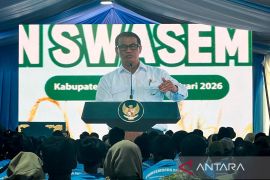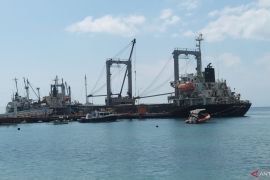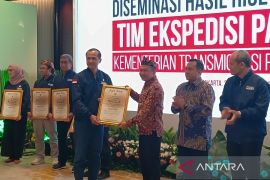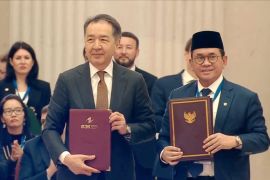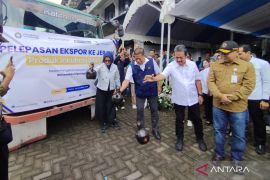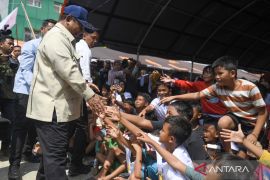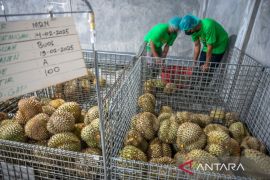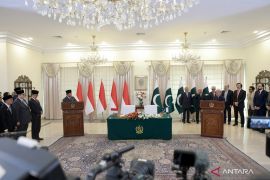In reality, Indonesian seaweed production increased ignificantly over the past five years from 2009 to 2010.
Of the 33 provinces across the country, five are the largest suppliers of seaweed , namely East Nusa Tenggara, South Sulawesi, Central Sulawesi, Bali, and Southeast Sulawesi.
Aquaculture expert Prof La Ode Muhammad Aslan of Haluoleo University (Unhalu) in Kendari, Southeast Sulawesi, said in Kendari on Saturday that in the past five years South Sulawesi produced 648,528 tons of seaweed followed by East Nusa Tenggara 606,273 tons, Central Sulawesi 287,263 tons, Bali 150,000 tons, and Southeast Sulawesi 123,486 tons.
La Ode said seaweed as the world trading commodity was in generally traded in the form of dried one, or ready to consume commodity such as Carrageenan.
Carrageenan is a substance with hydrocolloid properties owing to the presence of sulfated polyglycans with average relative molecular masses well above 100 kDa, derived from a number of seaweeds of the Rhodophyceae class.
It has no nutritional value but is used in food preparation for its gelling, thickening, and emulsifying properties.
Carrageenan is obtained by extraction of the seaweed into water or aqueous dilute alkali and may be recovered by alcohol precipitation, by drum drying, or by precipitation in aqueous potassium chloride and subsequent freezing.
Meanwhile, Bali provincial Maritime Affairs and Fisheries Office spokesman Gusti Putu Nuriatha said in Denpasar on Saturday that the Indonesian island resort has been able to produce 150,000 tons of seaweed in 2010 or increased by 42.8 percent from 105,000 tons in the previous year.
"The 150,000 tons of seaweed were harvested from a cultivation area of 707.7 hectares, covering the waters of Nusa Penida in Klungkung district, Kutuh Beach in Badung district, Benoa, Denpasar, and Bukti Beach in Buleleng district which serve as seaweed development centers in Bali," local Maritime Affairs and Fisheries Office spokesman Gusti Putu Nuriatha said here on Saturday.
He said the seaweed production centers in Bali had a great potential but unfortunately a small part of it has been used.
According to Gusti Putu Nuriatha, Nusa Penida is a small island located around 19 miles southeast of Bali that largely remains in its natural state, relatively untouched by tourism development.
Due to the island`s dry conditions, the high salinity levels ideally support seaweed industry that is based in Nusa Penida where crude bamboo pens are erected in shallow waters for seaweed to be harvested, dried naturally under the sun and then packed for export to different Asian nations.
The seaweed farmers in Nusa Penida have been asked to conserve endangered seaweed called "spinosum" variety and increase cultivation of the plant because it was found only in the coastal areas of the island.
Local people started to know that spinosum was endangered seaweed after researchers from the Bogor-based Institute of Agriculture and the Denpasar-based Udayana University conducted researches on the seaweed in Nusa Penida`s coastal area sometime ago.
"In the future the endangered seaweed species of spinosum variety can be developed optimally to increase its production by 353 percent in the next five years," Gusti Putu Nuriatha said.
Therefore he has provided the Nusa Penida farmers with 295 units of seaweed drying equipment.
Besides Nusa Penida, Nusa Lembongan island is also known as the biggest seaweed producing area in Bali.
Along with West Nusa Tenggara (NTB) East Nusa Tenggara (NTT) and Central and South Sulawesi, Bali is one of the most important seaweed producing areas in Indonesia.
The landscape of Nusa Lembongan, which is largely made up of gently inclined white sand, and the transparent seawater with suitably strong currents, make it ideal for the cultivation of seaweed.
Seaweed cultivation provides a livelihood for most of Nusa Lembongan`s residents while others earn their living from the tourist trade or work for the local government.
Seaweed accounts for a significant boost to the prosperity of the local communities. The most commonly grown types of seaweed are Cottonii and Spinosum.
With a traditional planting method, the local people have successfully expanded their farming areas, especially throughout the northern coast of Nusa Lembongan and Nusa Penida, as well as to the adjacent smaller island of Nusa Ceningan.
No wonder Marine Affairs and Fisheries Minister Fadel Muhammad has the ambition not only to turn Indonesia into a top global fish supplier but also the world`s biggest seaweed producer.
Fadel said every effort would be made to increase seaweed production on a mass scale to enable Indonesia become the biggest seaweed producer the world.
In Southeast Sulawesi, the local government fully supports the development of seaweed cultivation in Wakatobi and Muna districts.
Governor Nur Alam said in the provincial city of Kendari early this month that the local government`s support was given to the two districts in their effort to build large-scale seaweed processing plants.
"Two large-scale seaweed processing plants will in the near future be established respectively in the districts of Muna and Wakatobi, and therefore the local government should give its full support," Governor Nur Alam said.
Meanwhile, Bangka-Belitung (Babel) province has also set itself the target of cultivating one million tons of seaweed up to 2015 in the region`s coastal waters.
A spokesman of Babel`s marine and fisheries office, Fhores Fherado, said in Pangkalpinang recently that seaweed had a high economic value and if cultivated on a large scale, it could improve the welfare of the fishermen`s community in the province.
"We have so far cultivated around 25,000 tons of seaweed in the provincial waters but we have a target to increase it by one million tons by 2015," Fhores Fherado said.
To realize the cultivation of one million tons of seaweed in Babel waters, he said groups of fishermen in every region of the province had been empowered by giving them guidance on how to grow seaweed commercially.(*)
O001/HAJM
Reporter: Otniel Tamindael
Editor: Jafar M Sidik
Copyright © ANTARA 2011
